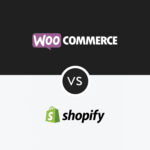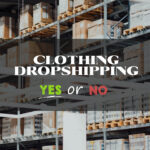It’s been 2023! Are you still waiting and hesitating to start your own clothing business? Are you always thinking it’s not the best time? You know, stop thinking, action is everything! People who already start have gained something, whatever wealth or experience, it’s worthy and beneficial!
More importantly, you can start your clothing business with dropshipping without dealing with inventory management, shipping hassles, or affording high upfront costs. Dropshipping might just be the perfect solution for you!
If you’re interested in diving into the world of e-commerce and want to start a clothing business in dropshipping this year, you’ve come to the right place. In this comprehensive guide, we will walk you through the entire process, providing you with actionable insights, tips, and steps to get your clothing dropshipping business up and running smoothly.
Understanding the Basics – How Dropshipping Runs
Before we delve into the nitty-gritty of starting your clothing dropshipping business, let’s first ensure we’re on the same page regarding what dropshipping entails. Dropshipping is a business model where you, as the retailer, don’t need to keep an inventory of the products you sell. Instead, you partner with a supplier who takes care of storing the merchandise and fulfilling orders on your behalf. This means that you can focus on marketing, customer service, and growing your business without worrying about the logistics of product storage and shipping.
Now that we have a clear understanding of dropshipping let’s explore the steps to start your clothing dropshipping business in 2023.

Learn more about dropshipping in these articles:
2 Steps to Start a Clothing Dropshipping Business
No need to worry about what’s new to you, dropshipping is not that complicated. As long as you start, things will go smoothly, now let’s start easily with 2 steps!
Setting Up Your Online Store
Researching and Choosing the Right Platform
An online store is the beginning of starting your clothing dropshipping business. When it comes to choosing the right platform, there are several options available, each with its pros and cons. Let’s explore some of the most popular platforms:
- Shopify: Shopify is a user-friendly and feature-rich platform that offers a seamless experience for beginners. It provides numerous templates, customization options, and integrations to enhance your store’s functionality.
- WooCommerce: If you prefer a more flexible and customizable solution, WooCommerce, a plugin for WordPress, might be the right choice for you. It allows you to have full control over your store’s design and functionality.
- BigCommerce: BigCommerce is a comprehensive platform that caters to businesses of all sizes. It offers powerful built-in features, scalability, and excellent customer support.
Choose Shopify or WooCommerce:
How to set up Shopify Store:
Designing Your Online Store
Once you’ve chosen your preferred platform, it’s time to design your online store. The design plays a crucial role in attracting and engaging potential customers, so it’s essential to create a visually appealing and user-friendly interface. Consider the following tips:
- Choose a clean and modern theme that aligns with your brand and target audience.
- Optimize your website for mobile devices to provide a seamless experience for users on smartphones and tablets.
- Use high-quality product images to showcase your clothing items effectively.
Adding Products to Your Store
With your online store set up, it’s time to start adding products to your inventory. This is where the dropshipping model shines, as you won’t need to purchase and store items upfront. Instead, you can leverage the extensive network of clothing suppliers available to dropshippers.
- Find Reliable Clothing Suppliers: Look for reputable clothing suppliers that offer a wide range of products, competitive prices, and reliable shipping services. Platforms like KakaClo, Fashiongo, and Faire can connect you with trustworthy suppliers.
- Import Product Listings: Most dropshipping platforms provide integrations that allow you to import product listings directly from suppliers’ websites. This saves you time and effort in manually adding each product to your store.
- Optimize Product Descriptions: Take the time to craft compelling and SEO-friendly product descriptions. Use relevant keywords naturally throughout the text to improve your store’s visibility in search engine results.
KakaClo is the best B2B apparel online marketplace for dropshippers, particularly beginners. You can find more fashion possibilities with extensive collections of women’s, men’s, and kids’ clothing. The best part? It’s completely free to use, with no monthly fees holding you back. Seamlessly integrated with Shopify and WooCommerce, KakaClo empowers you to effortlessly import products in just a few clicks. Say goodbye to the hassles of managing inventory and shipment – KakaClo streamlines the entire order process, leaving you free to focus on growing your business.
Marketing and Promoting Your Store
Now that your store is up and running, it’s crucial to implement effective marketing strategies to drive traffic and boost sales. Here are some proven tactics to consider:
Search Engine Optimization (SEO)
SEO is the process of optimizing your website to improve its visibility in search engine rankings. By incorporating relevant keywords, creating high-quality content, and building backlinks, you can attract organic traffic to your online store.
Social Media Marketing
Utilize the power of social media platforms to promote your clothing dropshipping business. Create captivating content and post on high-engaged platforms like Instagram, Pinterest, and TikTok, run targeted ad campaigns, and collaborate with influencers to reach a broader audience and generate brand awareness.
Remember to make full use of free traffic in the beginning, and this means you need to invest more time and energy to work on content.
Email Marketing
Build an email list and leverage it to nurture relationships with your customers. Send regular newsletters, exclusive discounts, and personalized recommendations to keep your audience engaged and encourage repeat purchases.
Learn more tips to market clothing business:
Conclusion
Starting a clothing dropshipping business in 2023 has been easier than before as dropshipping has been proven a feasible and lucrative model with more supplier/product options and more convenient e-channel integrations. Especially, clothes come so complicated with more SKUs than other businesses.
Follow the steps outlined and start your entrepreneurial journey with confidence. With dedication, perseverance, and the right resources, you can find your way out and achieve remarkable success in the fashion industry.
FAQs
Q: How much money do I need to start a clothing dropshipping business?
A: The amount of money required to start a clothing dropshipping business can vary depending on factors such as your chosen niche, marketing budget, and website development costs. However, compared to traditional retail models, dropshipping generally requires a lower upfront investment.
Q: Can I sell clothing from multiple suppliers?
A: Absolutely! Working with multiple suppliers can provide you with a more extensive product catalog and a diversified range of styles and designs to offer your customers. Just make sure to manage your inventory effectively and maintain good communication with each supplier.
Q: Is dropshipping a sustainable business model in the long run?
A: Dropshipping can be a sustainable business model if implemented correctly. It offers flexibility, scalability, and low overhead costs. However, it’s essential to continuously adapt to market trends, optimize your store, and provide excellent customer service to stay competitive and profitable in the long run.







